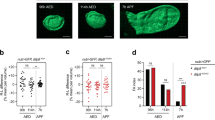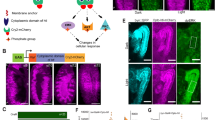Abstract
Homoeotic mutations of Drosophila lead to the replacement of one structure by another, for example, Antennapedia1 replaces the antenna with a mesothoracic leg and bithorax produces an anterior wing instead of the anterior haltere. The transformed structures differentiated by the homoeotic mutants are essentially normal—only the position in which they appear is abnormal. The mutant phenotypes suggest that in normal development homoeotic genes are involved in developmental alternatives and contribute to a genetic address that defines the particular developmental pathway taken by a primordial group of cells2–5. Thus, in the absence of homoeotic gene function, primordia in different positions should follow the same basic developmental pathway. This is indeed the case for embryos that show no activity of bithorax genes; thoracic and abdominal segments develop as mesothorax6. The simplest view on homoeotic gene function is that the genes act selectively on primordia depending on their position in the embryo. To test this hypothesis, we used a mutation at the Antennapedia locus, Antp73b, which transforms the antenna into a mesothoracic leg, and we observed the function of the homoeotic genes engrailed and Ultrabithorax in two apparently morphologically identical appendages which develop from primordia in different positions. Our results indicate that position is the relevant factor in the function of these two homoeotic genes.
This is a preview of subscription content, access via your institution
Access options
Subscribe to this journal
Receive 51 print issues and online access
$199.00 per year
only $3.90 per issue
Buy this article
- Purchase on Springer Link
- Instant access to full article PDF
Prices may be subject to local taxes which are calculated during checkout
Similar content being viewed by others
References
Lindsley, D. L. & Grell, E. H. Carnegie Inst. Wash. Publ. 627 (1968).
Lewis, E. B. Am. Zool. 3, 33–56 (1963).
Lewis, E. B. in The Role of Chromosomes in Development (ed. Locke, M.) 231–252 (Academic, New York, 1964).
Morata, G. & Lawrence, P. A. Nature 265, 211–216 (1977).
García-Bellido, A. Ciba Fdn Symp. 29, 161–182 (1975).
Lewis, E. B. Nature 276, 565–570 (1978).
Morata, G. & Lawrence, P. A. Nature 274, 473–474 (1978).
Morata, G. & Lawrence, P. A. Devl Biol. 70, 355–371 (1979).
Steiner, E. Wilhelm Roux's Arch. dev. Biol. 180, 31–46 (1976).
Morata, G. & Lawrence, P. A. Nature 255, 614–617 (1975).
Lawrence, P. A. & Morata, G. Devl Biol. 50, 321–337 (1976).
Kornberg, T. Devl Biol. 86, 363–372 (1981).
Morata, G. & Kerridge, S. Nature 290, 778–781 (1981).
Kerridge, S. & Morata, G. J. Embryol. exp. Morph. 68, 211–234 (1982).
Morata, G. & Ripoll, P. Devl Biol. 42, 211–221 (1975).
Author information
Authors and Affiliations
Rights and permissions
About this article
Cite this article
Morata, G., Kerridge, S. The role of position in determining homoeotic gene function in Drosophila. Nature 300, 191–192 (1982). https://doi.org/10.1038/300191a0
Received:
Accepted:
Issue Date:
DOI: https://doi.org/10.1038/300191a0
This article is cited by
Comments
By submitting a comment you agree to abide by our Terms and Community Guidelines. If you find something abusive or that does not comply with our terms or guidelines please flag it as inappropriate.



